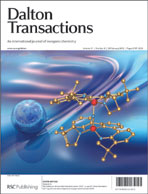The variable chelating behavior of 3-methoxysalicylaldehyde-4(N)-substituted thiosemicarbazones was observed in equimolar reactions with [PdCl2(PPh3)2]. The new complexes were characterized by various analytical, spectroscopic techniques (mass, 1H-NMR, absorption, IR). All the new complexes were structurally characterized by single crystal X-ray diffraction. Crystallographic results showed that the ligands H2L1and H2L4 are coordinated as binegative tridentate ONS donor ligands in the complexes 1 and 4 by forming six and five member rings. However, the ligands H2L2 and H2L3 bound to palladium in 2 and 3 as uninegative bidentate NS donors by forming a five member chelate ring. From this study, it was found that the substitution on terminal 4(N)- nitrogen may have an influence on the chelating ability of thiosemicarbazone. The presence of hydrogen bonding in 2 and 3 might be responsible for preventing the coordination of phenolic oxygen to the metal ion. The interaction of the complexes with calf-thymus DNA (CT-DNA) has been explored by absorption and emission titration methods. Based on the observations, an electrostatic binding mode of DNA has been proposed. The protein binding studies were monitored by quenching of tryptophan and tyrosine residues in the presence of complexes using Lysozyme as model protein. Antibacterial activity studies of the complexes have been screened against pathogenic bacteria such as Enterococcus faecalis, Staphylococcus aureus, Escherichia coli, Klebsiella pneumonia and Pseudomonas aeruginosa.MIC50 values of the complexes showed that they exhibited significant activity against the pathogens and among them, 3 exhibited higher activity. Further, anticancer activity of the complexes on the lung cancer cell line A549 has also been studied.

You have access to this article
 Please wait while we load your content...
Something went wrong. Try again?
Please wait while we load your content...
Something went wrong. Try again?


 Please wait while we load your content...
Please wait while we load your content...